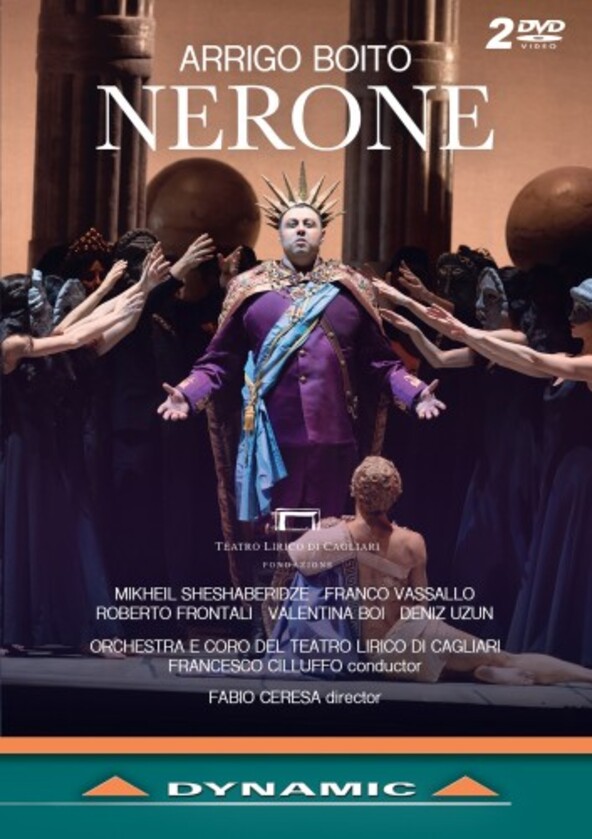BOITO Nerone (Cilluffo)
View record and artist detailsRecord and Artist Details
Genre:
Opera
Label: Dynamic
Magazine Review Date: 01/2025
Media Format: Digital Versatile Disc
Media Runtime: 154
Mastering:
DDD
Catalogue Number: 38047

Tracks:
| Composition | Artist Credit |
|---|---|
| Nerone |
Arrigo Boito, Composer
Antonino Giacobbe, Dositeo; Oracle, Baritone Cagliari Teatro Lirico Chorus Cagliari Teatro Lirico Orchestra Deniz Uzun, Rubria, Mezzo soprano Dongho Kim, Tigellino, Bass Francesco Cilluffo, Conductor Franco Vassallo, Simon Mago, Baritone Mikheil Sheshaberidze, Nerone, Tenor Natalia Gavrilan, Cerinto; Pèrside, Mezzo soprano Roberto Frontali, Fanuèl, Baritone Valentina Boi, Asteria, Soprano Vassily Solodkyy, Gobrias, Tenor |
Author: Mark Pullinger
Verdi’s librettist on Otello and Falstaff, Arrigo Boito was also a noted composer. His most famous work, Mefistofele, is still a comparative rarity on the world’s stages but his second opera, Nerone, is rarer still. Marking its centenary, Fabio Ceresa’s 2024 production at the Teatro Lirico di Cagliari was the opera’s premiere in Sardinia and the first new staging in Italy since the Teatro San Carlo in Naples mounted it in 1957 with tenor Mirto Picchi in the title-role.
Boito worked on the opera for over 50 years, leaving it incomplete on his death in 1918. He had originally conceived the work in five acts, writing the libretto himself, but Giulio Ricordi talked him out of setting the fifth, in which Nero suffers a mental breakdown with the appearance of the ghost of Agrippina, whom he has just murdered at the opera’s start. After his death, the opera was completed by Antonio Smareglia and Vincenzo Tommasini, and its debut came on May 1, 1924, at the Teatro alla Scala in Milan, conducted by Arturo Toscanini.
In the opera, the murderous emperor is caught in the web of power, intrigue and religious fanaticism woven by his opponents: the Christians Fanuèl and Rubria and the shady magician Simon Mago. With its clash of pagan and Christian worlds, Nerone echoes Wagner’s Parsifal, with the sacrilegious Asteria a Kundry-like character and Simon Mago the Klingsor figure. Wagner’s chromatic harmonies are laced into Boito’s score, too. It lacks the vocal opulence of Mefistofele but is still a fascinating piece, well worth resurrecting.
This is Nerone’s second appearance on DVD in recent years. Hugo Shirley welcomed the appearance of Olivier Tambosi’s production at the Bregenz Festival, a sinister, oppressive staging. In Cagliari, Ceresa offers quite a contrast to Tambosi. His staging depicts the plot more clearly, although Tiziano Santi’s sets and Claudia Pernigotti’s costumes unite the worlds of Ben-Hur and Italian fascism.
The dome of the Basilica of Santi Giovanni e Paolo (the only Roman basilica completed in the 20th century) features in Act 2, while the Circus Maximus of Act 4’s gladiatorial chariot race is replaced by a model of the monumental squared Colosseum in the EUR (Esposizione Universale Roma), the district designed to host a world expo where Mussolini planned to parade fascist glories. The production’s frontcloth shows the famous marble bust of Nero displayed in the Museo Archeologico Nazionale di Cagliari, which is also depicted in a high relief between the colonnades in the final act as Rome burns.
A young dancer sprayed in gold bodypaint represents Apollo, accompanying Nerone in the triumphant finale to Act 1 and, in a bull mask, raping the Vestal Virgin Rubria after she is thrown into the Arena in Act 4. Nerone does not appear in the final scene of Boito’s opera, a structural weakness, but Tambosi has him as a silent observer to Rubria’s death, while Ceresa has the emperor vindicate himself by slitting Apollo’s throat at the final curtain as Rome burns.
Ceresa’s staging is easier to penetrate than Tambosi’s, but both are recommendable, as, by and large, are both casts. Georgian tenor Mikheil Sheshaberidze is the weak link, a little provincial as Nerone. His voice has plenty of heft, but he sometimes appears awkward and doesn’t impart the same sense of gloom portrayed by the late Rafael Rojas in Bregenz. Franco Vassallo is incisive as Simon Mago, here in papal tiara, his sturdy baritone well contrasted with Roberto Frontali’s sensitive Fanuèl in their ideological battles, the latter in a crown of thorns during the opera’s second half. Valentina Boi unleashes plenty of power as Asteria, although her Bregenz counterpart Svetlana Aksenova is preferable. Deniz Uzun sings with beautiful sensitivity as Rubria.
Francesco Cilluffo, a regular Ceresa collaborator, is a splendid advocate for Boito’s complex score, drawing out the opera’s sombre harmonies and brassy monumentalism, and the chorus of the Teatro Lirico make splendid contributions.
Nerone is definitely an opera worth exploring and the productions by Ceresa and Tambosi both have their merits. Do you really need both? I’d be sorely tempted.
Discover the world's largest classical music catalogue with Presto Music.

Gramophone Digital Club
- Digital Edition
- Digital Archive
- Reviews Database
- Full website access
From £8.75 / month
Subscribe
Gramophone Full Club
- Print Edition
- Digital Edition
- Digital Archive
- Reviews Database
- Full website access
From £11.00 / month
Subscribe
If you are a library, university or other organisation that would be interested in an institutional subscription to Gramophone please click here for further information.




